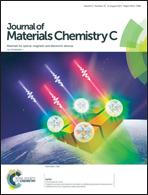Fluoride-sulfophosphate glasses as hosts for broadband optical amplification through transition metal activators†
Abstract
Unusually stable multi-anion glasses of the fluoride-sulfophosphate type (FPS) are introduced as a new host material for optically active cation species. Despite a notoriously low polymerization grade, anion mixing in this glass system enables facile manufacture of bulk or fiber devices which combine several advantages of fluoride and phosphate glasses while using the stabilizing effect of sulfate additions. Using the example of chromium doping, we demonstrate broad red photoluminescence at 734 nm and inhomogeneous broadening of the R-line at 694 nm, originating from the 4T2 → 4A2 and 2E → 4A2 transitions of Cr3+, respectively. The luminescence mechanism is further analyzed on the basis of the corresponding Tanabe–Sugano diagram. Tailored through chemical composition, internally nucleated precipitation of a nanocrystalline fluoride phase enables switching between high-field and low-field configurations of the Cr3+ ion, resulting in the specific emission properties and setting the path towards FPS-based optical devices.



 Please wait while we load your content...
Please wait while we load your content...